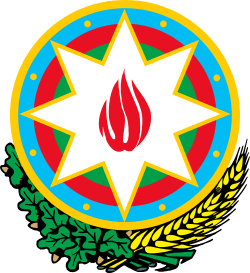Quba District (Azerbaijan)
| Quba Lezgian: Къуба район | |
|---|---|
| Rayon | |
| Azerbaijani: Quba rayonu | |
|
The arch bridge over the Qudyalçay connecting Quba (left) and Qırmızı Qəsəbə (right) | |
.svg.png) Map of Azerbaijan showing Quba Rayon | |
| Coordinates: 41°22′12″N 48°30′00″E / 41.37000°N 48.50000°ECoordinates: 41°22′12″N 48°30′00″E / 41.37000°N 48.50000°E | |
| Country |
|
| Capital | Quba |
| Area[1] | |
| • Total | 2,574 km2 (994 sq mi) |
| Population (2014)[2] | |
| • Total | 161,434 |
| • Density | 63/km2 (160/sq mi) |
| Time zone | AZT (UTC+4) |
| • Summer (DST) | AZT (UTC+5) |
| Postal code | 4000 |
| Telephone code | (+994) 23[3] |
| Website |
www |
Quba (Azerbaijani: Quba rayonu, Lezgian: Къуба район) is a rayon in northeastern Azerbaijan. The capital, Quba, is located on the Qudyal River at 41.37°N, 48.50°E.
The fertile region surrounding Quba is best known for its production of apples and the city area of Quba is known for its fine carpets.
Demographics
Azerbaijanis (All parts of district) - 71%, Tats (Southern parts) - 18% and Lezgians (Northwestern parts) - 9% are the largest ethnic groups of Quba District. Khinalugs (1%) are living in the village of Khinalug.
Languages
General information
| General information | |
|---|---|
| Total territory, [km2] | 2,610.00 |
| Total number of population | 143,100 |
| Number of villages | 155 |
| Number of settlements | 2 |
| Number of hospitals and medical enterprises | 16 |
| Number of culture centers | 194 |
Names of cities and big settlements
- Quba (city)
- Qırmızı Qəsəbə (settlement)
- Qonaqkənd (municipality and village)
- Qarovulüstü (village)
- Xaşı (village)
Names of border districts, countries and territories
Ismailly, Shamakhi, Gabala, Qusar, Khachmaz, Devechi, Khizi
History
Quba rose to prominence in the 18th century. In 1747, Nader Shah ruler of the Persian Empire was assassinated. That same year, Hussein-Ali, the Shah's designated ruler of the region, decided to attempt to unify the Azeri khanates as an independent kingdom. One of his first moves was moving his capital from the less defensible Xudat in the Caspian lowlands to Quba where he built a fortress. Hussein-Ali died in 1757 and his son Fatali Khan carried on the expansion with Quba reaping the riches of its status as the capital. Some ruins from this period, such as Çirax Qala on the way to Baku, exist today.
However, upon Fatali Khan's death in 1789, the city's fortunes began to turn. In 1806, the khanate was occupied and soon absorbed by the Russian Empire. As a result, the city fell into the background of Azerbaijani history and politics.
The city is home to several historic buildings, including the Juma Mosque (Cuma Məscid or Friday Mosque), Ardabil Mosque (Ərdəbil Məscid) and old hamman (baths).
The region is home to Azerbaijan's largest community of Mountain Jews in the community of Qırmızı Qəsəbə (formerly in Russian: Krasnaya Sloboda, English: Red Town), located just across the river from Quba City.
Information on historical and architectural monuments
Ancient Guba contains at least 134 historical and archeological monuments. These include the temple of Fire-worshippers near Khynalyg village, tombs of Aghbil village dating back to the 16th century, the Mosques Sakinekhanum, Hadjy Djafar and Djuma of Guba which dates back to the 19th century, and the Gumbezli bath house.
The district also has a bust of the state official A.A. Bakikhanov, the monument of great poet Samed Vurghun and a statue of The Unknown Soldier, dedicated to the memory of those killed in the Great Patriotic War. for mre info "http://journeyrich.ucoz.com"
Noted residents
- Abbasgulu Bakikhanov (also spelled Bakixanov or Bakikhanli), a 19th-century writer, historian and philosopher, is one of the most well known men in Azerbaijan and lived in town Amsar. His museum is located Quba city.
- Sakina Akhundzadeh, playwright, was born here in 1865
Population
- 1989 - 20,800
- 2004 - 42,300 (estimated)
Pictures of Quba Rayon




- Jek people, 20 August 2012.
| Part of the series on |
| Azerbaijan Azərbaycan |
|---|
  |
| Culture |
| History |
| Demographics |
| Geography |
| Administrative divisions |
| Azerbaijan portal |
References
- ↑ Äliyev, redaksiya heyätinin sädri, Ilham Heydär oğlu (2007). Azärbaycan : Azärbaycan milli ensiklopediyası. Bakı: "Azärbaycan Milli Ensiklopediyası" Elmi märkäzi. ISBN 9789952441017.
- ↑ "Əhalisi". Quba Rayon İcra Hakimi. Retrieved 11 November 2015.
- ↑ "Şəhərlərarası telefon kodları". Aztelekom MMC. Aztelekom İB. Retrieved 19 August 2015. (Azerbaijani)
